Jyotirlingas are sacred shrines dedicated to Lord Shiva, one of the principal deities in Hinduism. There are twelve prominent Jyotirlingas in India, each believed to be a manifestation of Lord Shiva.
Pilgrims and devotees embark on journeys to these sacred temples to seek the blessings of Lord Shiva and attain spiritual fulfillment. Here is a brief overview of the twelve Jyotirlingas
1. Somnath (Gujarat)

Somnath, located in Prabhas Patan near Veraval in Saurashtra, Gujarat, is one of the twelve sacred Jyotirlingas in India.
As a Jyotirlinga, Somnath holds great significance in Hindu mythology and is revered by millions of devotees. “Jyotirlinga” refers to a shrine where Lord Shiva is worshipped as a sacred and self-manifested lingam, symbolizing the infinite cosmic light.
The Somnath temple is believed to be the first among the twelve Jyotirlingas and is a place of immense spiritual importance.
Devotees from various parts of the country and beyond visit Somnath to seek the blessings of Lord Shiva and to experience the divine energy associated with this sacred pilgrimage site.
The temple’s location on the western coast adds to its allure, providing a serene backdrop for spiritual contemplation and devotion.
Somnath, situated in Prabhas Patan near Veraval in Saurashtra, Gujarat, holds a unique and revered place in Hindu mythology as one of the twelve sacred Jyotirlingas in India.
The term “Jyotirlinga” carries profound significance, representing a shrine where Lord Shiva is worshipped as a sacred and self-manifested lingam, symbolizing the infinite cosmic light.
The Somnath temple is considered the primary and foremost among the twelve Jyotirlingas, making it a site of unparalleled spiritual importance.
The presence of a Jyotirlinga signifies the divine embodiment of Lord Shiva’s cosmic energy, drawing millions of devotees to this sacred pilgrimage destination.
The temple’s location near the western coast of India adds to its allure, providing a picturesque and serene backdrop for spiritual contemplation and devotion.
The sound of the waves from the nearby Arabian Sea and the temple’s historical significance create an atmosphere that resonates with the profound spirituality associated with Lord Shiva.
The history of the Somnath temple is rich and varied, marked by several constructions and reconstructions over the centuries.
Despite facing numerous invasions and destructions, the temple has stood as a symbol of resilience and unwavering devotion. Its architecture reflects a blend of various artistic styles, showcasing the region’s cultural diversity over different periods.
The pilgrimage to Somnath is a religious journey and a cultural and historical experience. Devotees visit to witness the divine presence of the Jyotirlinga, participate in the daily rituals and aarti ceremonies, and immerse themselves in the spiritual ambiance that pervades the temple premises.
The Somnath temple complex encompasses the main shrine and various smaller temples, ghats, and other religious structures, creating a holistic pilgrimage experience.
The temple’s significance extends beyond religious boundaries, attracting visitors of diverse backgrounds who appreciate this sacred site’s historical, cultural, and architectural aspects.
2. Mallikarjuna (Andhra Pradesh)
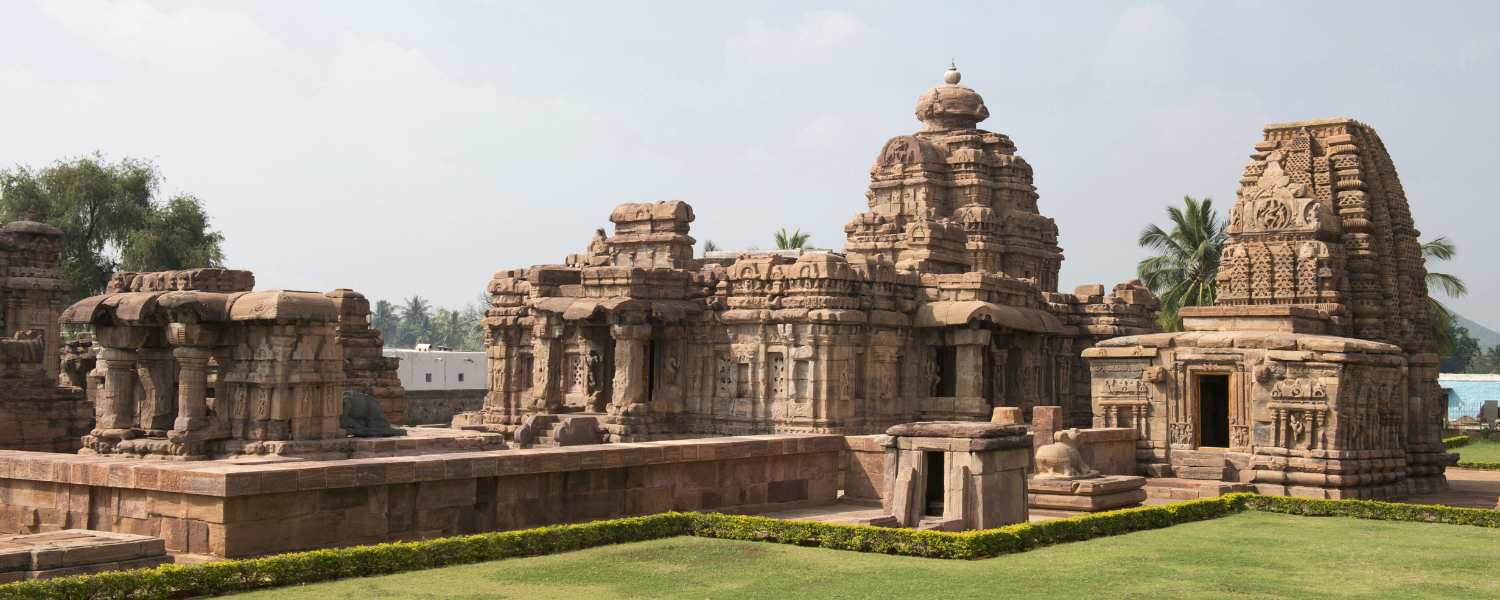
Mallikarjuna, situated in Srisailam, Andhra Pradesh, is one of the revered Jyotirlingas in India. “Jyotirlinga” signifies a sacred shrine where Lord Shiva is worshipped as a self-manifested lingam, symbolizing the infinite cosmic light.
The Mallikarjuna Jyotirlinga holds significant religious importance, drawing devotees and pilgrims from various parts of the country.
Srisailam, where the Mallikarjuna temple is located, is in the Nallamala Hills on the banks of the Krishna River. The temple’s serene surroundings and the divine presence of Mallikarjuna make it a spiritually charged destination for those seeking the blessings of Lord Shiva.
Devotees undertake a pilgrimage to Mallikarjuna to offer prayers and seek divine intervention. The temple’s architecture, religious rituals, and the sacred Jyotirlinga contribute to the overall spiritual experience, fostering a sense of reverence and devotion among visitors.
Mallikarjuna, situated in Srisailam, Andhra Pradesh, holds a special place as one of the revered Jyotirlingas in India. “Jyotirlinga” signifies a sacred shrine where Lord Shiva is worshipped as a self-manifested lingam, symbolizing the infinite cosmic light.
The Mallikarjuna Jyotirlinga is of significant religious importance, attracting devotees and pilgrims from various corners of the country.
Srisailam, the location of the Mallikarjuna temple, is nestled in the picturesque Nallamala Hills on the banks of the Krishna River.
The temple’s serene surroundings and the divine presence of Mallikarjuna contribute to creating a spiritually charged destination for those seeking the blessings and grace of Lord Shiva.
Devotees pilgrimage to Mallikarjuna to offer prayers, perform rituals, and seek divine intervention in their lives. The temple’s architecture reflects the cultural and historical heritage of the region.
At the same time, the religious rituals and ceremonies add to the overall spiritual experience, creating an atmosphere of devotion and reverence.
The sacred Jyotirlinga housed in the Mallikarjuna temple is a focal point for pilgrims. It symbolizes the formless aspect of Lord Shiva and is considered a source of divine energy and cosmic light. The darshan (sighting) of the Jyotirlinga is believed to bring spiritual merit and blessings to the devotees.
Beyond being a pilgrimage site, Srisailam is also known for its natural beauty and tranquil ambiance. The Nallamala Hills provide a scenic backdrop to the temple, offering pilgrims an opportunity for spiritual reflection and communion with nature.
The Mallikarjuna temple complex is not only a religious site but also a cultural and historical treasure. The temple architecture, the presence of other deities within the complex, and the rituals performed throughout the year contribute to the holistic experience of the pilgrimage.
3. Mahakaleshwar (Madhya Pradesh)

Mahakaleshwar, located in Ujjain, Madhya Pradesh, is one of the sacred Jyotirlingas in India. The term “Jyotirlinga” refers to a revered shrine dedicated to Lord Shiva, where the divine manifestation is symbolized by a self-manifested lingam, representing the eternal cosmic light.
The Mahakaleshwar Jyotirlinga is situated on the banks of the Rudra Sagar Lake in the ancient city of Ujjain. This temple is a significant pilgrimage site for devotees and holds historical and cultural importance.
The temple’s architecture, religious rituals, and the spiritual aura surrounding the Jyotirlinga attract pilgrims and visitors throughout the year. Devotees visit Mahakaleshwar to offer prayers, seek blessings, and participate in the religious ceremonies conducted at the temple.
The belief in the divine presence of Lord Shiva at this Jyotirlinga enhances the spiritual significance of the pilgrimage, creating a sacred and devout atmosphere for those who embark on this religious journey.
Mahakaleshwar, situated in Ujjain, Madhya Pradesh, stands as one of the sacred Jyotirlingas in India, each representing a revered shrine dedicated to Lord Shiva.
The term “Jyotirlinga” holds profound significance, symbolizing a shrine where the divine manifestation of Lord Shiva is symbolized by a self-manifested lingam, representing the eternal cosmic light.
The Mahakaleshwar Jyotirlinga is uniquely positioned on the banks of the Rudra Sagar Lake in the ancient city of Ujjain. This temple not only holds deep religious significance but also carries historical and cultural importance, making it a focal point for pilgrimage and spiritual exploration.
Devotees from various parts of the country visit Mahakaleshwar to offer prayers, seek divine blessings, and participate in the religious ceremonies conducted at the temple.
The belief in the divine presence of Lord Shiva at this Jyotirlinga enhances the spiritual significance of the pilgrimage, creating a sacred and devout atmosphere for those who embark on this religious journey.
The architecture of the Mahakaleshwar temple is a testament to the region’s cultural heritage, reflecting a blend of historical styles and artistic influences.
The temple complex encompasses the main shrine and various other structures, ghats, and kunds, adding to the overall spiritual ambiance.
The rituals performed at Mahakaleshwar are integral to the devotees’ experience. The daily aarti, abhishekam (ritual bathing), and other ceremonies contribute to the temple’s sanctity and allow worshippers to engage in acts of devotion and reverence. The temple’s priests and the resonating sounds of chants create an atmosphere of spiritual energy.
The city of Ujjain is an important pilgrimage destination in Hinduism, hosting various other temples and religious sites.
The Mahakaleshwar Jyotirlinga, a significant part of Ujjain’s religious landscape, draws pilgrims and tourists alike, seeking spiritual solace and a connection with the region’s rich cultural and historical tapestry.
4. Omkareshwar (Madhya Pradesh)
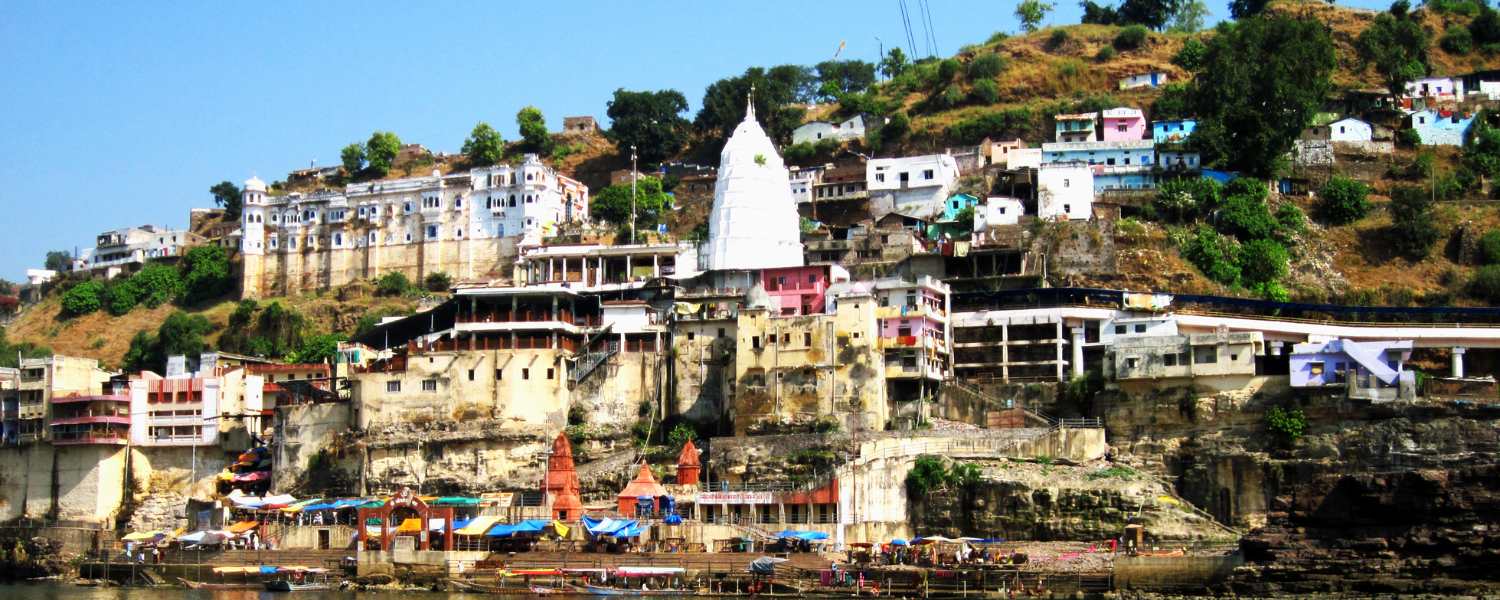
Omkareshwar, situated in Madhya Pradesh, is one of the prominent Jyotirlingas in India. “Jyotirlinga” refers to a revered shrine dedicated to Lord Shiva, symbolized by a self-manifested lingam, representing the eternal cosmic light.
The Omkareshwar Jyotirlinga is located on Mandhata Island in the Narmada River. The island is shaped like the sacred symbol “Om,” adding to the site’s spiritual significance.
Pilgrims and devotees visit this sacred temple to seek Lord Shiva’s blessings and experience the divine energy associated with the Jyotirlinga.
The Omkareshwar temple, with its unique location and religious significance, attracts a steady stream of visitors who come to perform rituals, attend religious ceremonies, and immerse themselves in the spiritual ambiance of this sacred Jyotirlinga.
The pilgrimage to Omkareshwar is considered auspicious and holds deep religious importance for followers of Lord Shiva.
Omkareshwar, situated in Madhya Pradesh, is one of India’s prominent Jyotirlingas. The term “Jyotirlinga” signifies a revered shrine dedicated to Lord Shiva, with the divine manifestation symbolized by a self-manifested lingam, representing the eternal cosmic light.
The Omkareshwar Jyotirlinga is uniquely located on Mandhata Island in the Narmada River. The island is shaped like the sacred symbol “Om,” a significant and encouraging emblem in Hinduism, adding spiritual significance to the site. This distinctive feature enhances the sanctity of Omkareshwar, making it a place of profound religious importance.
Pilgrims and devotees undertake journeys to Omkareshwar to seek Lord Shiva’s blessings and experience the divine energy associated with the Jyotirlinga.
The pilgrimage to this sacred temple involves performing rituals, attending religious ceremonies, and immersing oneself in the spiritual ambiance that pervades the site.
The Omkareshwar Lord Shiva temple, with its architectural grandeur and historical resonance, attracts a steady stream of visitors who come not only for religious reasons but also to appreciate the cultural and artistic aspects of the region.
The temple complex encompasses various structures, ghats, and kunds, creating a comprehensive and holistic pilgrimage experience.
The location of Omkareshwar on the Narmada River adds to its natural beauty, providing a serene backdrop for spiritual contemplation.
The flowing waters of the sacred river contribute to the overall ambiance, creating an atmosphere conducive to prayer, meditation, and introspection.
The pilgrimage to Omkareshwar is considered auspicious and holds deep religious importance for followers of Lord Shiva.
The darshan (sighting) of the Jyotirlinga is believed to bring spiritual merit and blessings, making the journey to Omkareshwar a revered and timeless tradition for devotees.
5. Kedarnath (Uttarakhand)
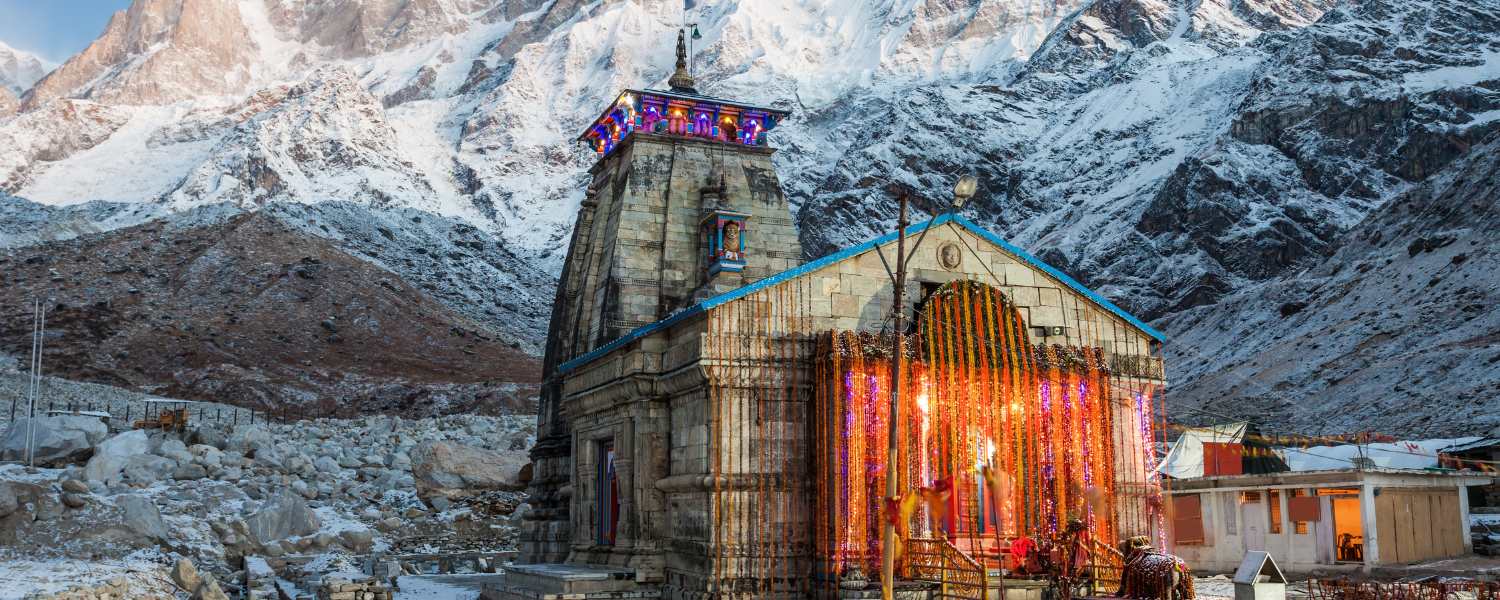
Kedarnath, nestled in the Himalayan state of Uttarakhand, is a revered pilgrimage site and one of the prominent Jyotirlingas in India.
The term “Jyotirlinga” refers to a sacred representation of Lord Shiva in the form of a self-manifested lingam, symbolizing cosmic light.
The Kedarnath Jyotirlinga holds immense religious significance and is about 3,583 meters (11,755 feet) above sea level in the Garhwal Himalayas. Pilgrims undertake a challenging journey to reach the holy shrine, one of the Char Dham Yatra circuit destinations.
The Kedarnath temple is surrounded by breathtaking mountainous landscapes and is believed to have been established by the sage Adi Shankaracharya in the 8th century.
Devotees visit the temple to seek Lord Shiva’s blessings and participate in the religious rituals and ceremonies at this sacred Jyotirlinga.
Kedarnath, nestled in the majestic Himalayan state of Uttarakhand, stands as a revered pilgrimage site and one of the prominent Jyotirlingas in India.
The term “Jyotirlinga” signifies a sacred representation of Lord Shiva in the form of a self-manifested lingam, symbolizing the eternal cosmic light.
The Kedarnath Jyotirlinga holds immense religious significance and is about 3,583 meters (11,755 feet) above sea level in the Garhwal Himalayas.
This sacred shrine is a part of the Char Dham Yatra circuit, a pilgrimage route that includes other prominent Hindu destinations like Badrinath, Gangotri, and Yamunotri.
The journey to Kedarnath is considered a challenging yet spiritually rewarding endeavor. Pilgrims undertake a trek through rugged mountainous terrain to reach the holy shrine, a testament to the devotion and determination of those who seek the divine presence of Lord Shiva. The picturesque landscapes and the pristine beauty of the Himalayas add to the sanctity of the pilgrimage.
The Kedarnath temple is believed to have been established by the renowned sage Adi Shankaracharya in the 8th century.
The temple’s architecture reflects the region’s rich cultural and religious heritage, and its surroundings are adorned with breathtaking views of snow-capped peaks and alpine meadows.
Devotees pilgrimage to Kedarnath to seek Lord Shiva’s blessings and participate in the religious rituals and ceremonies at this sacred Jyotirlinga.
The darshan (sighting) of the Lingam is considered highly auspicious, and pilgrims engage in prayers, meditation, and acts of devotion to connect with the divine.
The Kedarnath Yatra is not merely a physical journey but a spiritual odyssey that transcends the challenges of the terrain.
The serene ambiance, the purity of the mountain air, and the sense of divine presence contribute to a transformative experience for those undertaking this sacred pilgrimage.
6. Bhimashankar (Maharashtra)
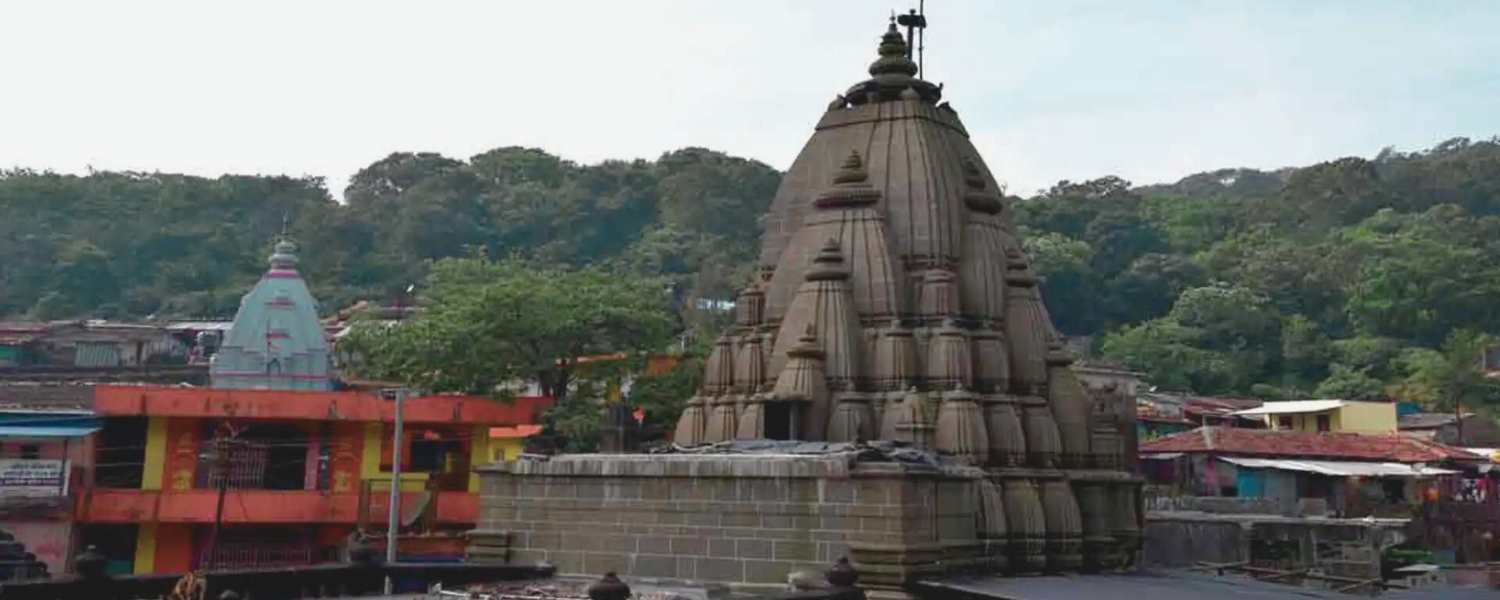
Bhimashankar, nestled in Maharashtra, holds a significant place among the Jyotirlingas in India. The term ‘Jyotirlinga’ represents the sacred manifestation of Lord Shiva, and people revere Bhimashankar as one of these divine forms.
Located in the Sahyadri range of the Western Ghats, Bhimashankar is surrounded by lush greenery and natural beauty, creating a serene, spiritually charged ambiance.
The temple dedicated to Lord Shiva attracts devotees and spiritual seekers from across the country, making it a prominent pilgrimage site.
The legend of Bhimashankar traces back to the Mahabharata, where Lord Shiva is believed to have taken the form of Bhima to defeat the demon Tripurasura.
The presence of the Bhima River, which originates nearby, enhances the sanctity of Bhimashankar, further elevating its spiritual significance.
Devotees undertake a pilgrimage to Bhimashankar to seek the divine blessings of Lord Shiva and to experience the sacred energy associated with this Jyotirlinga. The journey involves physical travel and a spiritual quest for inner peace and divine connection.
The temple at Bhimashankar showcases the region’s architectural and cultural richness, reflecting Maharashtra’s historical and religious heritage.
Pilgrims engage in various religious rituals, including darshan (sighting) of the Jyotirlinga, prayer ceremonies, and acts of devotion to express their reverence and seek the divine grace of Lord Shiva.
The natural surroundings of Bhimashankar, set amidst the Western Ghats, add to the holistic experience of the pilgrimage.
The lush landscapes, cool mountain air, and tranquil environment create an atmosphere conducive to spiritual contemplation and reflection.
7. Kashi Vishwanath (Uttar Pradesh)

Kashi Vishwanath, located in Varanasi, Uttar Pradesh, is a sacred and revered Jyotirlinga in India. The term “Jyotirlinga” signifies the divine representation of Lord Shiva, and Kashi Vishwanath holds a special place among the twelve Jyotirlingas spread across the country.
The Kashi Vishwanath Temple stands on the western bank of the holy river Ganges in Varanasi, one of India’s oldest and holiest cities. Devotees from across the country and beyond visit this sacred temple to seek the blessings of Lord Shiva.
The significance of Kashi Vishwanath runs deep in Hindu mythology and scriptures. People believe that a pilgrimage to Kashi (Varanasi) and a visit to the Kashi Vishwanath Temple can help attain moksha (liberation from the cycle of birth and death).
The temple complex is a place of spiritual vibrancy and cultural richness. The Ghats of Varanasi along the Ganges River add to the divine atmosphere, making it a destination of immense religious importance.
Pilgrims and tourists flock to Varanasi to experience the profound spiritual energy emanating from Kashi Vishwanath, making it a key destination among the Jyotirlingas in India.
Kashi Vishwanath, situated in the ancient and sacred city of Varanasi, Uttar Pradesh, holds a position of profound reverence as one of the twelve Jyotirlingas in India.
The term ‘Jyotirlinga’ signifies Lord Shiva’s divine manifestation, and people esteem Kashi Vishwanath for its spiritual and historical significance.
People built the Kashi Vishwanath Temple on the western bank of the sacred Ganges River in Varanasi, a city revered for its antiquity and holiness.
Devotees from across the nation and worldwide make pilgrimages to this sacred temple to seek the blessings and divine presence of Lord Shiva.
The roots of the significance of Kashi Vishwanath delve deep into Hindu mythology and scriptures. People firmly believe that undertaking a pilgrimage to Kashi, specifically visiting the Kashi Vishwanath Temple, can bestow moksha—liberation from the perpetual cycle of birth and death. This belief adds to the sanctity and allure of the temple, drawing pilgrims on a quest for spiritual enlightenment.
The temple complex itself is not only a religious site but also a cultural and spiritual hub. The ghats lining the Ganges River in Varanasi contribute to the overall divine ambiance, creating an environment rich in tradition and religious fervor.
The spiritual vibrancy of Kashi Vishwanath resonates through the city, attracting both devout pilgrims and curious tourists seeking a glimpse into the spiritual heart of India.
With its ancient history and cultural heritage, Varanasi has become a destination transcending time’s physical boundaries.
The rituals, ceremonies, and the continuous flow of pilgrims add to the dynamic character of Kashi Vishwanath, making it a paramount pilgrimage site among the Jyotirlingas.
8. Trimbakeshwar (Maharashtra)
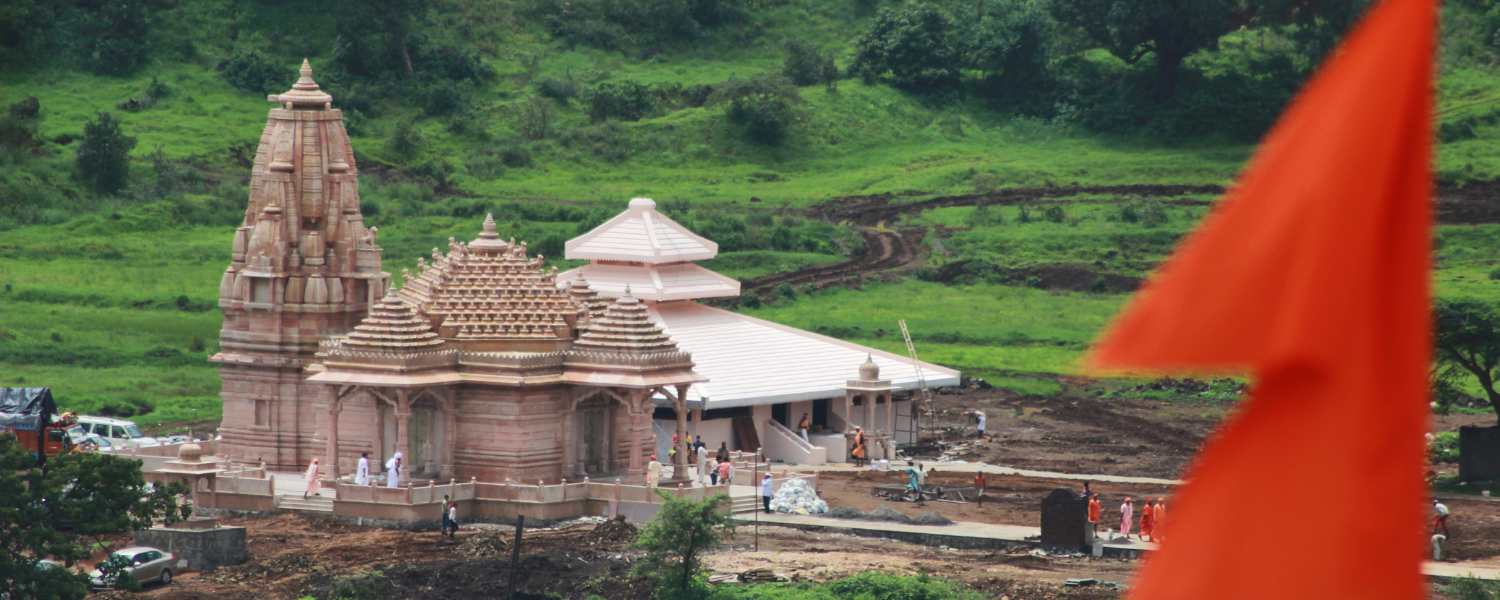
Trimbakeshwar, located in the Nashik district of Maharashtra, stands as one of the twelve Jyotirlingas in India. Devotees dedicate the Trimbakeshwar Jyotirlinga to Lord Shiva, and it holds great religious significance for Hindus
Here are some key points about the Trimbakeshwar Jyotirlinga
1. Location: Trimbakeshwar is located near Nashik in Maharashtra. People situate the temple at the source of the Godavari River.
2. Significance: People associate the Trimbakeshwar Jyotirlinga with the origin of the Godavari River, and they believe it to be one of the holiest places for performing various religious rites.
3. Kushavarta Kund: Pilgrims consider Kushavarta Kund, a sacred pond near the temple, to be holy. They believe that taking a dip in this pond during the Kumbh Mela (a major Hindu festival) brings encouragement.
4. Unique Linga: The linga at Trimbakeshwar is unique because it features three faces representing Lord Brahma, Lord Vishnu, and Lord Rudra (Shiva). It symbolizes the unity of the Holy Trinity.
9. Vaidyanath (Jharkhand)

Vaidyanath Jyotirlinga, also known as Vaidyanath Dham or Vaijnath Temple, stands as one of the twelve Jyotirlingas in India dedicated to Lord Shiva.
In Deoghar in the Santhal Parganas division of Jharkhand, Vaidyanath is a revered pilgrimage destination for Hindu devotees.
Here are some key points about Vaidyanath Jyotirlinga
1. Location: Vaidyanath Jyotirlinga is in the town of Deoghar in Jharkhand, India.
2. Significance: People believe the temple to be a sacred abode of Lord Shiva, holding great significance in Hindu mythology. Devotees visit Vaidyanath to seek the blessings of Lord Vaidyanath, the ‘Physician of the Gods.’
3. Jyotirlinga Appearance: The Lingam at Vaidyanath is a swayambhu lingam, meaning it self-manifests. Adorning the Lingam, a mukha, or face, makes it one of the most sacred representations of Lord Shiva.
4. Vaidyanath Dham: People refer to the temple complex as Vaidyanath Dham, which includes other shrines dedicated to various deities. The temple stands as an architectural marvel, featuring intricate carvings and designs.
10. Nageshwar (Gujarat)

Nageshwar Jyotirlinga, also known as Aundha Nagnath, stands as one of the twelve Jyotirlingas in India dedicated to Lord Shiva. It lies in the state of Gujarat, near Dwarka. Below are some key points about Nageshwar Jyotirlinga.
1. Location: Nageshwar Jyotirlinga is in the Daarukavanam Kshetra near Dwarka in Gujarat, India.
2. Jyotirlinga Appearance: The Lingam at Nageshwar is unique as it faces south, unlike the other Jyotirlingas that face east. People believe the Lingam to be swayambhu, meaning self-manifested.
3. Significance: Hindu mythology describes Nageshwar as one of the Dwadasa Jyotirlingas mentioned in the Shiva Purana. It holds immense significance for Lord Shiva’s devotees.
4. Dwarka Connection: Nageshwar Jyotirlinga is located near the Dwarka temple, and pilgrims often visit it as part of the pilgrimage.
5. Legend and Mythology: The legend of Nageshwar Jyotirlinga revolves around a demon named Daruka, who kidnapped Supriya, a devotee of Lord Shiva.
Supriya advised all the captives to recite the mantra “Om Namah Shivaya” to protect themselves. Pleased with the devotion, Lord Shiva appeared to defeat the demon and protect his devotees, leading to the manifestation of the Jyotirlinga.
6. Architectural6. Architectural Style: The temple exhibits a simple yet majestic architectural style common in ancient Hindu temples.
Intricate carvings and sculptures surround the temple’s main sanctum, where they depict various deities and mythological scenes, along with the enshrined Jyotirlinga.
7. Festivals and Celebrations: Major Hindu festivals, especially Maha Shivratri, are celebrated enthusiastically at Nageshwar Jyotirlinga.
During these festivals, the temple decorators elaborate its decorations, and thousands of devotees visit to offer prayers and participate in special rituals and pujas.
8. Pilgrimage Route: Nageshwar Jyotirlinga forms an essential part of the pilgrimage route for Shaivites. Pilgrims often visit it along with nearby religious sites like Dwarkadhish Temple in Dwarka and Somnath Temple in Prabhas Patan.
9. Cultural Importance: The temple serves as both a religious site and a cultural hub. It plays a significant role in preserving and promoting the spiritual and cultural heritage of Hinduism, especially in the Gujarat region.
10. Accessibility and Facilities: Roads lead directly to the temple, connecting it to major cities in Gujarat.
Facilities for pilgrims, including accommodation and food services, are available near the temple area, catering to visitors’ needs.
11. Rameshwar (Tamil Nadu)
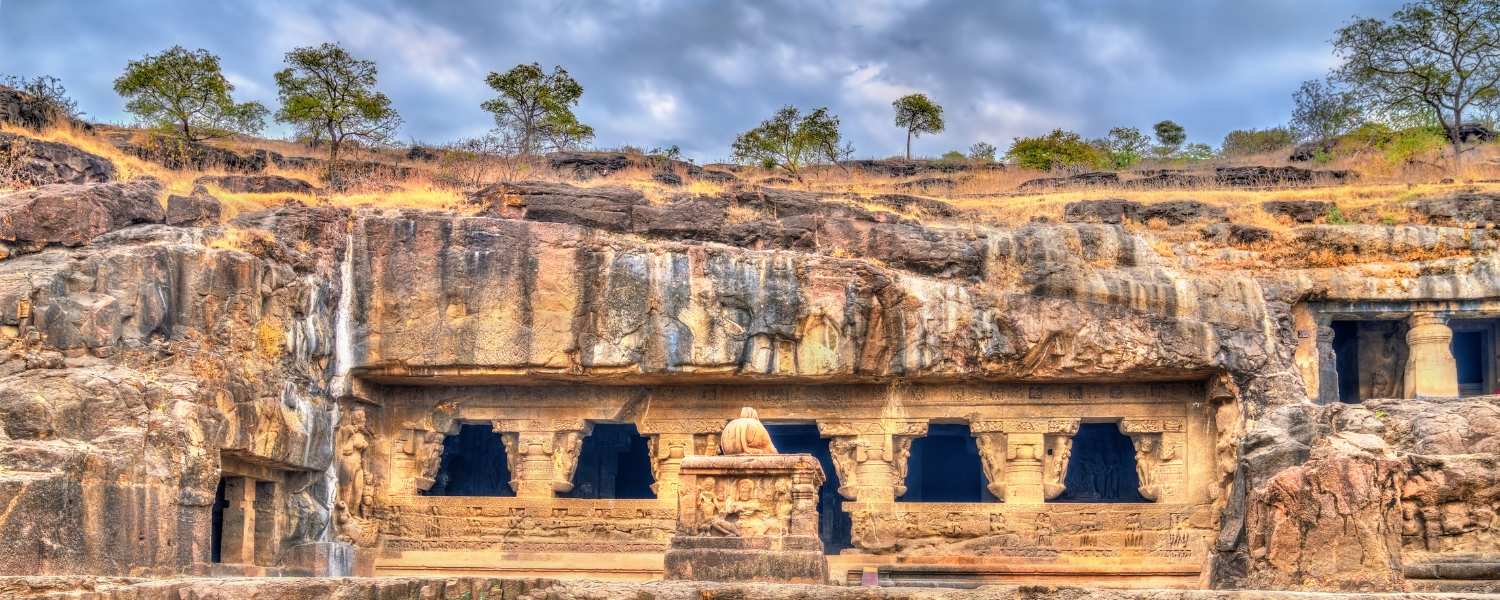
There might be a slight confusion in the name. People know the Jyotirlinga in Tamil Nadu as ‘Ramanathaswamy’ or ‘Rameswaram,’ not ‘Rameshwar.’ Below are some key points about the Ramanathaswamy Jyotirlinga.
1. Location: Ramanathaswamy Jyotirlinga is in the town of Rameswaram in Tamil Nadu, India.
2. Significance: It is one of the twelve Jyotirlingas, sacred to Lord Shiva, and holds great religious and spiritual significance in Hinduism.
3. Pilgrimage Destination: People consider Rameswaram one of India’s holiest pilgrimage places and part of the Char Dham Yatra.
4. Ramanathaswamy Temple: Devotees dedicate the main temple, known as the Ramanathaswamy Temple, to Lord Shiva. They consider the Lingam one of the twelve Jyotirlingas, and they highly revere it
5. Architectural Splendor: People renowned the Ramanathaswamy Temple for its magnificent Dravidian architecture. One of its most notable features is the longest corridor in any Hindu temple in India, with intricately carved pillars adorning it.
6. Mythological Significance: According to the Ramayana, Lord Rama, along with Sita and Lakshmana, worshipped Shiva here on their return from Lanka. People believe that Lord Rama established the Shiva lingam at this site.
7. Theerthams (Sacred Wells): Around 22 theerthams (sacred wells) are within the temple complex. Pilgrims view bathing in these waters as auspicious, with each theertham offering different benefits and linking to historical legends.
8. Floating Stone: The temple also houses the famous floating stone, believed to be a part of the Ram Setu (Adam’s Bridge) that Lord Rama and his army built to cross over to Lanka.
9. Festivals and Rituals: The temple celebrates festivals yearly, with Maha Shivaratri being the most significant. Thousands of pilgrims flock to the temple during these festivals to offer prayers and participate in the rituals.
10. Cultural and Religious Harmony: Interestingly, the temple’s history also signifies Hindu-Muslim unity. The story goes that a Muslim ruler gave the sea route to Sri Lanka for the temple’s consecration.
11. Roads and rails connect Rameswaram, making it accessible for pilgrims and tourists. The town and surrounding areas also offer various accommodation options for different budgets.
12. Environmental Significance: The region around Rameswaram is rich in biodiversity, especially marine life, making it a spiritual destination and a place of natural beauty.
12. Grishneshwar (Maharashtra)

Grishneshwar Jyotirlinga is one of the twelve Jyotirlingas sacred to Lord Shiva. Here are some key details about Grishneshwar Jyotirlinga
1. Location: Grishneshwar Jyotirlinga is near Ellora in Maharashtra, India.
2. Significance: It holds great religious and spiritual significance in Hinduism as one of the twelve Jyotirlingas, considered the most sacred abodes of Lord Shiva.
3. Grishneshwar Temple: Devotees dedicate the main temple, known as the Grishneshwar Temple or Grushneshwar Jyotirlinga Temple, to Lord Shiva. Pilgrims consider the Lingam self-manifested (Swayambhu), and they regard the temple as an important pilgrimage site.
4. Legend: According to mythology, the story of Grishneshwar centers around a devout woman named Kusuma. People say that Lord Shiva appeared as a Jyotirlinga to resolve the conflict between Kusuma and her husband.
5. Architectural Style: Grishneshwar Temple is an excellent example of South Indian temple architecture with beautiful carvings and sculptures. Red rocks make up the temple, adding to its unique appearance.
6. Historical Significance: People believe that Ahilyabai Holkar, a notable queen and patron of architecture, rebuilt the current structure of Grishneshwar Temple in the 18th century. This adds a historical dimension to its religious importance.
7. Ellora Caves Proximity: The temple’s proximity to the Ellora Caves, a UNESCO World Heritage Site, makes it part of a broader cultural and historical journey. The Ellora Caves represent religious harmony, featuring Buddhist, Hindu, and Jain monuments.
8. Festivals and Celebrations: Major Hindu festivals, especially Maha Shivratri and the Shravan month celebrations, attract many devotees.
During these festivals, priests conduct special rituals and pujas. Additionally, they decorate the temple festively, which enhances the spiritual atmosphere and draws even more visitors.
9. Pilgrims often visit Grishneshwar as the first or last Jyotirlinga in the circuit of the twelve Jyotirlingas, particularly those undertaking a comprehensive pilgrimage. In addition, it holds a special place in their spiritual journey.
10. Sacred Rituals: Devotees often perform rituals like Abhishekam and offer prayers at the temple to seek blessings. People know the temple for its serene and spiritual atmosphere.
11. Accessibility and Facilities: Roads provide easy access to the temple, which connects smoothly to major cities in Maharashtra. Facilities for pilgrims, including accommodation and food services, are available nearby.
12. Environmental Surroundings: The temple area lies near the Sahyadri mountains, surrounded by scenic beauty that adds a tranquil backdrop to the spiritual experience.
Conclusion
The journey through the sacred Jyotirlingas of India is a profound exploration of spirituality, devotion, and cultural richness.
These twelve revered shrines dedicated to Lord Shiva hold immense significance in Hindu mythology, attracting millions of pilgrims and devotees seeking divine blessings.
From the ancient shores of Somnath in Gujarat, where the cosmic light is first manifested, to the Himalayan heights of Kedarnath in Uttarakhand, each Jyotirlinga narrates a unique tale of faith and devotion. The temples, nestled in diverse landscapes, stand as timeless symbols of the divine presence of Lord Shiva.
The spiritual odyssey continues through the cultural heartland of India, exploring the mystical realms of Omkareshwar in Madhya Pradesh and the historical grandeur of Kashi Vishwanath in Varanasi, Uttar Pradesh. These sacred abodes offer glimpses into Hindu mythology and serve as cultural heritage centers.










